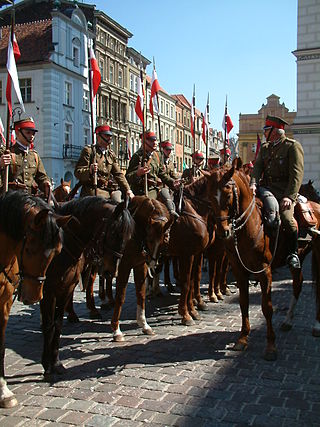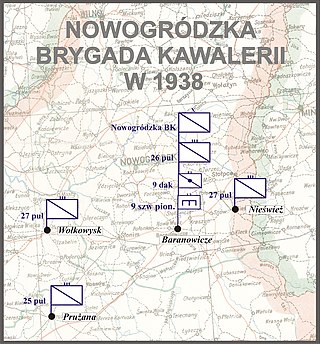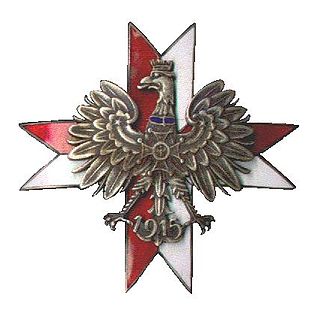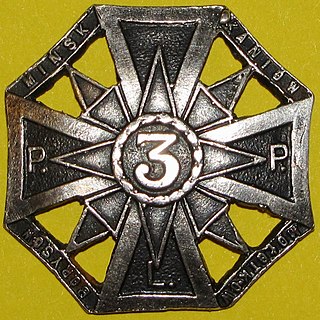
The Polish cavalry can trace its origins back to the days of medieval cavalry knights. Poland is mostly a country of flatlands and fields and mounted forces operate well in this environment. The knights and heavy cavalry gradually evolved into many different types of specialised mounted military formations, some of which heavily influenced western warfare and military science. This article details the evolution of Polish cavalry tactics, traditions and arms from the times of mounted knights and heavy winged hussars, through the times of light uhlans to mounted infantry equipped with ranged and mêlée weapons.

The Battle of Kock was the final battle in the invasion of Poland at the beginning of World War II in Europe. It took place between 2–5 October 1939, near the town of Kock, in Poland.

The Battle of Komarów, or the Zamość Ring, was one of the most important battles of the Polish-Soviet War. It took place between 20 August and 2 September 1920, near the village of Komarowo near Zamość. It was the last large battle in Europe in which cavalry was used as such and not as mounted infantry.

The Volhynian Cavalry Brigade was a Polish cavalry brigade, which saw action against the invading Germans during the Invasion of Poland, a part of World War II. Raised from recruits in the area of Wołyń, the division was posted to the Łódź Army. During several desperate counter-attacks, the brigade suffered heavy casualties near Łódź. It was commanded by Colonel Julian Filipowicz. Most notably, the unit took part in one of the first battles of the German invasion of Poland, the battle of Mokra.

Polish 1st Legions Infantry Division is a tactical formation of the Polish Army. Formed on February 20, 1919, partially of veterans of the I Brigade of the Polish Legions, the unit saw extensive action during the Polish-Soviet War and World War II. Regarded by the soldiers of the Wehrmacht as the Iron Division, it distinguished itself in the Invasion of Poland.

Battle of Lasy Królewskie refers to the battle on 1 September 1939 near Janowo and Krzynowłoga Mała during the Battle of the Border of the Invasion of Poland.

The Battle of Kałuszyn, took place between 11 and 12 September 1939 around the town of Kałuszyn near Mińsk Mazowiecki in Poland. It was part of the invasion of Poland at the start of World War II between forces of the Polish Army and the invading German Army.
The Polish 4th Infantry Division was created following Polish independence after the end of World War I. The division participated in the Polish–Ukrainian War in 1919. During World War II, the division existed as three wholly separate organizations, the original incarnation of the division as part of the pre-war Polish Army, the second incarnation armed and equipped by the western Allies, and another division armed and equipped and controlled by the Soviet Union. The second and third incarnations of this division existed simultaneously from 1944 until 1947.

The I Army Corps was a corps of the German army during World War II. It was active between 1934 and 1945, and participated in the Invasion of Poland, the Battle of France and the campaigns on the Eastern Front before eventually ending the war trapped in the Courland Pocket.

The 9th Infantry Division was a unit of the Polish Army in the Second Polish Republic. For most of 1919, the 9th Division's regiments were dispersed across the regions of Podlachia, Polesie and Volhynia, with one battalion sent to Dąbrowa Basin.

Nowogródzka Cavalry Brigade was a cavalry unit of the Polish Army in the interbellum period. It was created on April 1, 1937, out of the Baranowicze Cavalry Brigade. It took its name from Nowogródek town. Its headquarters were stationed in the town of Baranowicze. It consisted of several units, garrisoned in several towns located in northeast part of pre-1939 Poland:

Suwalska Cavalry Brigade was a cavalry unit of the Polish Armed Forces of the Second Polish Republic in the interbellum period. It was created on April 1, 1937, out of the 4th Independent Cavalry Brigade. Its headquarters were stationed in Suwałki and the brigade consisted of these units:
The IV Cavalry Corps of the Grande Armée was a French military unit that existed during the Napoleonic Wars. The corps was created in 1812 and rebuilt in 1813 and 1815. Emperor Napoleon I first organized the corps for the invasion of Russia. Under General Victor de Fay de La Tour-Maubourg, the corps fought at Borodino. During the War of the Sixth Coalition in 1813, General François Étienne de Kellermann commanded the all-Polish corps at Leipzig.

The First Krechowce Uhlan Regiment was a mounted unit of the Polish Army, active in the Second Polish Republic. Its traditions were continued during World War II, by a regiment of the same name, which was part of Polish Armed Forces in the West. The First Krechowce Uhlan Regiment was formed in 1915, as a unit of the Imperial Russian Army. It fought in World War I, Polish–Soviet War and the Invasion of Poland, as part of Suwalska Cavalry Brigade. Until 1939, the regiment was stationed in Augustów. It ceased to exist in 1947. The first commander of the regiment was a Tsarist officer of Polish ethnicity, Colonel Bolesław Mościcki, who was killed in 1918 near Luninets. The last commander was Colonel Leon Strzelecki.

The 9th Lesser Poland Uhlan Regiment was a cavalry regiment of the Polish Army, formed on November 21, 1918. Its first commandant was Rittmeister (Rotmistrz) Józef Dunin-Borkowski. The regiment fought in the Polish–Ukrainian War, Polish–Soviet War and the Invasion of Poland. In the Second Polish Republic, it was garrisoned in the towns of Czortków and Trembowla, and in 1939, it was part of Podolska Cavalry Brigade. The 9th Regiment was named after historic Polish province of Lesser Poland.

3rd Legions' Infantry Regiment was an infantry unit of Polish Legions in World War I, Polish Army and the Home Army. It existed in 1914–1939 and 1944–1945.

The 2nd Grochów Uhlan Regiment of General Jozef Dwernicki was a cavalry regiment of Polish I Corps in Russia, Polish Army in the Second Polish Republic, and the Home Army during Operation Tempest (1944). The regiment was formed in November 1917 in Volhynia, and in 1921–1939, it was garrisoned in Suwałki, in the barracks of former Imperial Russian Army's 2nd Pskov Dragoons Regiment. In the 1939 Invasion of Poland it was part of Suwalska Cavalry Brigade.

7th Lublin Uhlan Regiment of General Kazimierz Sosnkowski was a cavalry unit of the Polish Army in the Second Polish Republic and in the Polish Armed Forces in the West. Until 1939, it was garrisoned in Mińsk Mazowiecki. The day of the regiment was on March 23, the anniversary of the decoration of its flag with the Virtuti Militari.

17th Greater Poland Uhlan Regiment of King Bolesław Chrobry was a cavalry unit of the Polish Army in the Second Polish Republic. Formed in late 1918, it was garrisoned in Leszno. The regiment, whose patron was King Bolesław Chrobry, fought in the Polish–Soviet War and the 1939 Invasion of Poland, as part of Wielkopolska Cavalry Brigade.

5th Legions Infantry Regiment of Józef Piłsudski was an infantry regiment of the Polish Army in 1918–1939. It was garrisoned in Vilnius as part of the 1st Legions Infantry Division.


















